Class 7 Maths Chapter 6 Practice Question Answers - Lines and Angles
Q1. Two supplementary angles are in the ratio 4 : 5. The angles are
(a) 90∘,90∘
(b) 80∘,100∘
(c) 30∘,150∘
(d) 45∘,45∘
Ans: (b)
Sol: Let the angles be 4x and 5x
Angles are supplementary
∴ 4x + 5x = 180∘
⇒9x = 180∘
⇒ x = 20∘
So the angles are
4 × 20∘ = 80∘
5 × 20∘ = 100∘
Q2. The complement of (90∘ −a) is :
(a) −a
(b) 90∘ +a
C90∘ −a
(d) a
Ans: (d)
Sol: Let the complement be y.
We know, two angles are complementary if their sum is 90∘ .
∴ 90∘ −a + y = 90∘
⇒ y = a.
Hence, option D is correct.
Q3. Find the angle which is 20o more than its supplement.
(a) 90
(b) 95
(c) 100
(d) 105
Ans: (c)
Sol: Let the required angle be x, then its supplement =(180 − x)
Given that x = (180 − x) + 20
⇒ 2x = 200
⇒ x = 100
Q4. Find the angle which is 30o more than its complement.
(a) 50o
(b) 55o
(c) 60o
(d) 65o
Ans: (c)
Sol: Let the required angle be x.
Then, its complement =(90o −x).
Given, the angle is 30o more than its complement.
Then, x=(90o −x)+30o
⇒ x + x=90o +30o
⇒ 2x=120o
⇒ x = 120o/2
⇒ x = 60o
Q5. Find the angle which is equal to its supplement
(a) 80o
(b) 90o
(c) 110o
(d) 154o
Ans: (b)
Sol: Let the required angle be x, then its supplement = (180o − x)
Given that x = (180o − x)
⇒ 2x = 180o
⇒ x = 90o
Q6. If a transversal intersects a pair of lines in such a way that the sum of interior angles on the same side of transversal is 180o , then the lines are
(a) parallel
(b) intersecting
(c) coincident
(d) None of these
Ans: (a)
Sol: If a transversal intersects a pair of lines in such a way that the sum of interior angles on the same side of transversal is 180∘ then the lines are parallel.
Option A is correct.
Q7. If two angles are complementary of each other, then each angle is:
(a) an obtuse angle
(b) a right angle
(c) an acute angle
(d) a supplementary angle
Ans: (c)
Sol: We know, two angles whose sum is equal to 90o are known as complementary angles.
Also, acute angle is the angle which is greater than 0o and less than 90o .
Hence, if two angles are complement of each other, then each of them should necessarily be acute angle.
Therefore, option C is correct.
Q8. If one angle of a linear pair is acute, then its other angle will be ______.
(a) Obtuse angle
(b) Acute angle
(c) Right angle
(d) None of these
Ans: (a)
Sol: Given: An angle of a linear pair is acute i.e., it is less than 90∘ .
We know that linear pair of angles are supplementary i.e., they add up to form 180∘
So the other angle must be greater than 90∘
So the other angle should be obtuse.
Q9. Find the measure of the complementary angle of each of 20∘.
(a) 50∘
(b) 70∘
(c) 160∘
(d) 80∘
Ans: (b)
Sol: We know, two angles are complementary when they add up to 90∘ .
Given, measure of one complementary angle is =20∘
⇒ Measure of other complementary angle = 90∘ - 20∘ = 70∘
∴ Measure of a complementary angle of 20∘ = 70∘
Therefore, option B is correct.
Q10. A ray stands on a line, then the sum of the two adjacent angles so formed is ______.
(a) 180∘
(b) 90∘
(c) 360∘
(d) 270∘
Ans: (a)
Sol: If a ray stands on a line, then the sum of two adjacent angles so formed is equal to 180∘ which is also known as a linear pair.
Q11. If two straight lines intersect, the measures of the vertically opposite angles are ________.
(a) equal
(b) not equal
(c) cannot be determined
(d) Nont of these
Ans: (a)
Sol: If two straight lines intersect, the measures of the vertically opposite angles are Equal.
To prove : ∠CBE=∠DBA
We know,
∠CBE+∠DBC=180∘ ( Linear Pair)
∠CBE=180∘ −∠DBC→ (I)
Again,
∠DBA+∠DBC=180∘ ( Linear Pair)
∠DBA=180∘ −∠DBC→ (II)
∴∠CBE=∠DB(a)
Q12. If an angle is 28∘ less than its complement, find its measure.
(a) 31∘
(b) 131∘
(c) 28∘
(d) 32∘
Ans: (a)
Sol: Let the required angle be x.
Then, its complement = (90∘ - x)
Given, the angle is 28∘ less than its complement.
Then, x = (90∘ - x) - 28∘
⇒ x + x = 90∘ - 28∘
⇒ 2x = 62∘
x = 62∘ / 2
x = 31∘
Q13. Find the measure of the supplementary angle of 138∘ .
(a) 48∘
(b) 42∘
(c) 52∘
(d) 38∘
Ans: (b)
Sol: Two angles are supplementary when they add upto form 180∘.
Given, one angle = 138∘.
Let the supplement angle be x
Hence, x = 180∘ - 138∘ = 42∘
Hence, supplementary angle of the following angle is 42∘.
Q14. Supplementary angle of 102∘ is:
(a) 180∘
(b) 90∘
(c) 78∘
(d) 60∘
Ans: (c)
Sol: As sum of supplementary angles if 180∘
Supplementary angle of 102∘ = 180∘ −102∘ = 78∘
Q15. Find the measure of the supplementary angle of 132∘ .
(a) 48∘
(b) 32∘
(c) 42∘
(d) 38∘
Ans: (a)
Sol: Two angles are Supplementary when their sum is equal to 180∘ .
If one angle =132∘ , let the other angle be x.
Hence, x + 132∘ = 180∘
x = 180∘ − 132∘
= 48∘
Hence, supplementary angle of 132∘ is 48∘ .
Q16. Which angles in the given figure are complementary?
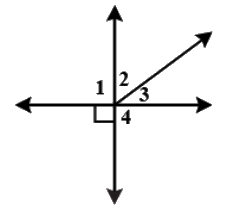 (a) ∠1 and ∠2
(a) ∠1 and ∠2
(b) ∠2 and ∠3
(c) ∠3 and ∠4
(d) ∠4 and ∠1
Ans: (b)
Sol: We know, two angles whose sum is equal to 90∘ are known as complementary angles.
Here, the sum, ∠2+∠3, is vertically opposite to a perpendicular.
⇒∠2 + ∠3=90∘ .
Hence ∠2 and ∠3 are complementary.
Therefore, option B is correct.
Q17. If two interior angles on the same side of a transversal intersecting two parallel lines are in the ratio 3:7, then the measure of the larger angle is
(a) 54∘
(b) 120∘
(c) 126∘
(d) 108∘
Ans: (c)
Sol: Let the angles be 3x and 7x.
We know that sum of two interior angles on the same side of transversal is 180∘ .
3x + 7x = 180∘
⇒ 10x = 180∘
⇒ x = 18∘
Therefore, the greater angle is 7x = 7 × 18∘ = 126∘
Q18. Find the measure of the complementary angle of 90∘ .
(a) 0∘
(b) 45∘
(c) 90∘
(d) 60∘
Ans: (a)
Sol: The pair of angles is said to be complementary, when their sum is 90∘ .
Let x, y be any two complementary angles and (∠x) = 90∘
⇒ (∠x) + (∠y) = 90∘ ........ (By definition of complementary angles)
90∘ + (∠y) = 90∘
(∠y) = 0∘
Hence, measure of complementary angle of 90∘ is 0∘ .
Q19. Given : AB || C(d) If ∠4 is an obtuse angle, then ∠5 is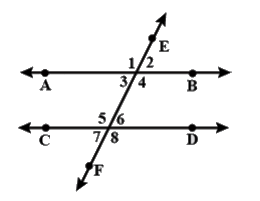
(a) Acute
(b) Right
(c) Obtuse
(d) Straight
Ans: (c)
Sol: As AB∣∣CD and EF is transversal.
∠5=∠4 (Alternate angles)
Now ∠4 is obtuse therefore ∠5 is also obtuse
Q20. If two lines intersect such that four vertical angles are equal, then each angle is:
(a) 45∘
(b) 100∘
(c) 180∘
(d) 90∘
Ans: (d)
Sol: Let each vertical angle be x
Now the sum of vertical angles is 360∘
⇒ x + x + x + x = 360∘
⇒ 4x = 360∘
⇒ x = 360∘ / 4 = 90∘
So option D is correct.
Q21. Which two angles are supplementary?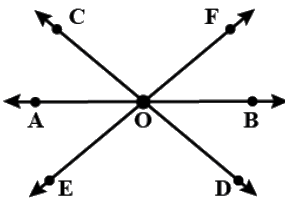
(a) ∠COF and ∠AOC
(b) ∠COF and ∠COE
(c) ∠COF and ∠EOD
(d) ∠COF and ∠AOE
Ans: (b)
Sol: ∠COF and ∠COE are supplementary because they formed on the line EOF
⇒ ∠COF + ∠COE = 180∘
So option B is correct.
Q22. The complementary angle of 30∘ is:
(a) 60∘
(b) 90∘
(c) 150∘
(d) none of these
Ans: (a)
Sol: We know, two angles are complementary when they add up to 90∘
Given, measure of one complementary angle is 30∘
⇒ Measure of other complementary angle = 90∘ - 30∘ = 60∘
∴ Measure of a complementary angle of 30∘ =60∘
Hence, option A is correct.
Q23. The measure of ∠POQ in the following figure is: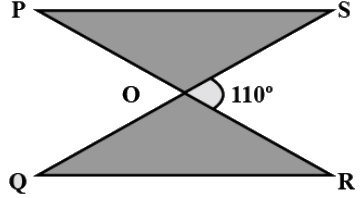
(a) 90∘
(b) 70∘
(c) 20∘
(d) 110∘
Ans: (d)
Sol: If two straight lines intersect the measures of vertically opposite angles are equal.
Given, ∠SOR=110∘
Therefore, ∠SOR=∠POQ
⇒∠POQ=110∘
Q24. If sum of two angles is 90∘ . They will be:
(a) Linear pair
(b) Supplementary angles
(c) Complementary angles
(d) Corresponding angles
Ans: (c)
Sol: By definition we know that two angles, the sum of whose measure is 90∘ are called complimentary angles.
Then, such angles are called complement of each other.
E.g.: Let the measure of one complementary angle is 58∘ .
⇒ Measure of other complementary angle = 90∘ - 58∘ = 32∘
∴ Measure of the complementary angle of 58∘ = 32∘
Hence, 58∘ and 32∘ are complements of each other.
That is, if the sum of two angles is 90∘
Therefore, option C is correct.
Q25. Two adjacent angles whose sum is 180∘ is called
(a) complementary angles
(b) linear pair
(c) vertically opposite angles
(d) none
Ans: (b)
Sol: Two adjacent angles whose sum is 180∘ is called linear pair.
Ex: 70∘ + 110∘ = 180∘ then these two angles is called a linear pair.
Q26. A line which intersects two or more lines at different points is:
(a) perpendicular
(b) transversal
(c) parallel
(d) none of these
Ans: (b)
Sol:
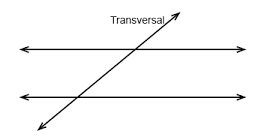
(A) Perpendiculars are the lines which intersect each other.
(C) Parallel lines do not intersect each other at any point.
(B) In geometry, a line that passes through two or more lines in the same plane at two or more different points is called transversal.
Transversals play a role in establishing whether two other lines in the Euclidean plane are parallel.
Hence, option B is correct.
Q27. p∣∣q,r∣∣s then p is _____.
(a) p∣∣s
(b) p∣∣r
(c) not parallel to s
(d) none of these
Ans: (c)
Sol: Given p∣∣q and r∣∣s.
No relation is given between line p with r and s
So p is not parallel to s
Option C is correct.
Q28. A pair of angles with a common vertex and common arm are called
(a) Adjacent angles
(b) Complementary
(c) Supplementary
(d) None
Ans: (a)
Sol: A pair of angles with a common vertex and common arm are called adjacent angles.
Q29. Two angles the sum of whose measure is 90∘ are called ______ angles.
(a) Supplementary
(b) Complementary
(c) Corresponding
(d) None of these
Ans: (b)
Sol: By definition we know that two angles, the sum of whose measure is 90∘ are called complementary angles. Then, such angles are called complement of each other.
Therefore, option B is correct.
Q30. The supplement of an acute angle is a/an __________ angle.
(a) Acute
(b) Obtuse
(c) Right
(d) Straight
Ans: (b)
Sol: We know acute angle <90∘
Let us take an example.
∠x = 45∘ .....x is an acute angle
Supplement of x is
180∘ - 45∘ = 135∘ ....it is an Obtuse angle
Obtuse angle >90∘ .
|
76 videos|452 docs|39 tests
|
















